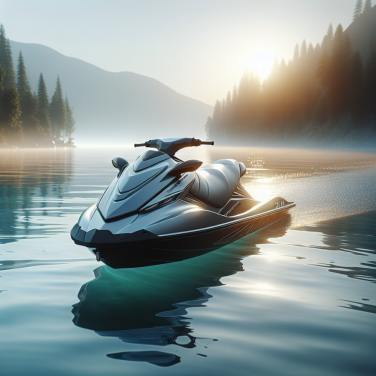Sure! Here is an expanded section for a professional blog under the topic "The Ultimate Guide to Personal Watercraft (PWC) Fun and Safety":
When it comes to enjoying the thrills of Personal Watercraft, commonly known as PWCs or jet skis, understanding both how to maximize the fun and ensure safety is key. Engaging in this exciting water-based activity takes more than just a love for speed and spray; it requires a solid foundation of knowledge, preparation, and respect for the rules of the waterways. Below you'll find comprehensive insights to elevate your personal watercraft experience while keeping safety at the forefront.
**Pre-Ride Preparations**
Always perform a pre-ride check. Ensure that your PWC is in good working order by checking the fuel levels, battery charge, and that all the critical systems, such as steering and throttle, are functioning properly. Don't forget to verify that your drain plug is secure; a simple oversight such as a loose plug could lead to your Craft taking on water. Also, equip your jet ski with the necessary safety gear, which includes life vests for each rider and a safety lanyard.
**Rider Proficiency**
Next, make sure that all riders understand how to operate the PWC safely. This often includes taking a safety course which is required or highly recommended in many jurisdictions. The course covers how to steer and control speed, and what to do in case of capsizing, as well as navigational rules such as avoiding restricted areas and respecting no-wake zones.
**Understanding Local Regulations**
Prior to setting out on the water, educate yourself on the local rules and regulations where you'll be riding. This includes speed limits, age requirements for riders, and any special PWC operating hours. Knowing these can prevent accidents and avoid fines.
**Safety Gear and Equipment**
In addition to life vests, every rider should have a whistle or horn for signaling in case of an emergency. Other important safety equipment includes a fire extinguisher, a safety flag for visibility, and, if you're planning to be out past dusk, proper navigational lights.
**Navigating with Caution and Courtesy**
Operating your PWC with caution and courtesy is not just about adhering to legal requirements but also about being a responsible member of the watercraft community. Maintain safe distances from other vessels, swimmers, and stationary objects. Avoid aggressive maneuvers near other water users, and be considerate of wildlife and the marine environment.
Read also:
Maximizing Muscle: A Guide to Powerlifting Essentials
Maximizing Your Enjoyment: Tips for Enhancing Your Personal Watercraft Experience
Maximizing your enjoyment of personal watercraft (PWC) adventures is all about enhancing both the safety and excitement of your rides. Whether you're a seasoned rider or new to the thrill of PWCs, these tips will help you elevate your experience on the water.
Before hitting the waves, invest in a pre-ride inspection. This involves checking the condition of your PWC to ensure everything is functioning correctly. Look over the engine, hull, and steering system, and verify that your safety equipment, such as life vests, are in good condition and easily accessible.
Understanding the capabilities and limits of your PWC is critical. Familiarize yourself with how your PWC handles in different water conditions, such as choppy seas or calm lakes. This will help you ride responsibly while pushing the envelope of excitement in a safe manner. If you own a PWC that's new to you, take some time to get to know it in a controlled environment before venturing into more challenging conditions.
Proper riding technique greatly enhances the enjoyment of your PWC. Keep your body relaxed yet alert, gripping the handlebars firmly but without unnecessary tension. Use your legs and core to absorb the shocks from waves, and lean into turns to improve maneuverability. Additionally, knowing how to reboard your PWC in deep water is essential for both safety and confidence during your rides.
Upgrade your experience by exploring new destinations. Take your PWC to various types of water bodies, from serene lakes to coastal areas where you can jump ocean swells. Each environment offers unique challenges and views, keeping your rides fresh and stimulating. Just be sure to always comply with local regulations and understand the wave and marine traffic patterns of new areas.
Communication is key when riding with friends or in groups. Use hand signals or waterproof communication devices to stay connected, especially in noisy or windy conditions. Not only does this enhance safety, but it also makes coordinating movements and activities more effortless, creating a more engaging experience for everyone involved.
Perhaps one of the most exciting ways to amplify your PWC exploits is by engaging in watersports. Many PWC models can tow wakeboarders, skiers, or inflatable tubes. Ensure your PWC has the appropriate towing capabilities and you are equipped with the right gear before engaging in these activities. Remember, towing requires heightened attention to safety, clear communication, and adherence to maritime laws.
Finally, taking care of your physical condition contributes greatly to maximizing enjoyment on your PWC.
Navigating the Waves Safely: Essential Safety Measures for Personal Watercraft Riders
Navigating the waves on a personal watercraft (PWC) is one of the most exhilarating experiences one can have on water. The wind in your hair, the spray of the sea on your skin, the thrilling speeds, and the freedom to go wherever you wish; it's a unique combination of excitement, adventure, and fun. However, with the power and freedom of PWCs comes the responsibility to operate them safely to ensure a fun day out on the water doesn't turn into a tragedy. In this section, we'll discuss essential safety measures every PWC rider should take.
Firstly, knowing and understanding local laws and regulations is crucial before setting out. This includes speed limits, age requirements, operating zones, and any specific local rules. Non-compliance not only risks fines and penalties but also endangers everyone's safety.
Equally important is the completion of a boater safety course which provides invaluable information about navigation rules, emergency procedures, and environmental stewardship. These courses are often mandated by law and completion is sometimes linked to insurance premium reductions.
Before launching your PWC, a pre-departure check should be done every time. This includes inspecting the fuel level, battery, and general condition of the craft. Additionally, checking the weather forecast can help avoid any unpleasant surprises that could compromise safety out on the water.
PWC riders should always wear a Coast Guard-approved life jacket, regardless of swimming ability. The life jacket should fit snugly and be suitable for PWC use. Besides the life jacket, the safety gear must include a whistle or horn for signaling, and if applicable, a visual distress signal.
The engine cut-off switch, a safety feature that stops the engine if the rider falls off, must be attached to the rider at all times. This can prevent runaway watercraft situations that can cause serious injuries or even fatalities.
Riders should maintain a proper lookout at all times for other watercraft, swimmers, divers, and obstacles in the water. Maintaining a safe distance from other vessels and giving the right of way as per navigational rules is vital for preventing collisions.
The effects of alcohol and drugs are significantly increased on the water due to the marine environment's stresses, such as motion, vibration, engine noise, sun, wind, and spray. Therefore, it’s imperative to avoid substances that impair judgement and reaction times while operating a PWC.
Understanding and using appropriate riding etiquette is also a key aspect of safety.




